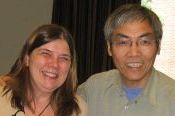Hashimoto's Disease, Anita Daniels-Gilletti
Hashimoto’s Disease, also known as chronic lymphocytic thyroiditis, causes inflammation of the thyroid gland that often leads to an under active thyroid (hypothyroidism). It’s an autoimmune disorder in which your immune system inappropriately attacks the thyroid gland, causing damage to the thyroid cells and upsetting the balance of chemical reactions in the body. Hashimoto’s disease is the most common cause of hypothyroidism in the United States.
The thyroid is part of the endocrine system, which is made up of several glands and tissues that produce hormones. These hormonal chemical messengers coordinate many of the body’s functions, from digestion to metabolism to reproduction.
Symptoms can include sensitivity to cold, constipation, elevated cholesterol levels, pale, dry skin, puffy face, joint or muscle aches, depression, or excessive menstrual bleeding.
Normally, your immune system uses naturally occurring proteins (antibodies) and white blood cells (lymphocytes) to help protect against viruses, bacteria and foreign substances that invade the body. Hashimoto’s disease is an autoimmune disorder in which your immune system creates antibodies that damage your thyroid, creating inflammation which may impair the ability of the thyroid to produce hormones. This triggers the pituitary to produce more TSH, or thyroid stimulating hormone, thus causing the thyroid to enlarge, possibly forming a goiter.
Modern medicine doesn’t know what causes the immune system to attack the thyroid gland. Some scientists think a virus or bacteria might trigger the response, while others think a genetic flaw may be involved.
There are certain blockages we, as practitioners of the Tom Tam Healing system, always find when working with Hashimoto’s patients. Each patient will a have a physical knot or restriction at cervical vertebra number 6, as well as thoracic vertebras 1, 2 and 3. In the Tom Tam Healing System these relate to the thyroid itself (C6) and the immune system. (T I, 2, 3.) T 4 and 7 can also be affected. T 1 relates to bone marrow, T 2 to the thymus gland, T 3 to the lymph. T4 relates to the function of the skin to eliminate toxins and T7 relates to the spleen. We can also check the neck area, usually around acupuncture point SI 16, LI 17 or LI 18 to open the superior thyroid artery. Energetic blockages can also be sensed in the hypothalamus and pituitary area deep inside the brain. We can open these blockages a number of ways. Tong Ren can work energetically to open the hypothalamus and pituitary by tapping on the prefrontal cortex area of the head. (GV 22 line, across the head.) The Sensory cortex can also be added to help pass the message from the hormone center (target hormones) to the target organs, in this case the thyroid.
Acupuncture and Tuina can open the physical blockages along the neck and spine, thus allowing sufficient blood and bio-electricity to pass to the various immune related organs and the thyroid.
In our healing practice, both autoimmune and hormone imbalances respond favorably in almost all cases. Many people’s functions return to normal. In the case of Hashimoto’s disease, this is supported by the TSH count returning to within normal ranges, and the patient’s reduction or elimination of symptoms, as their overall health and well being is restored.




